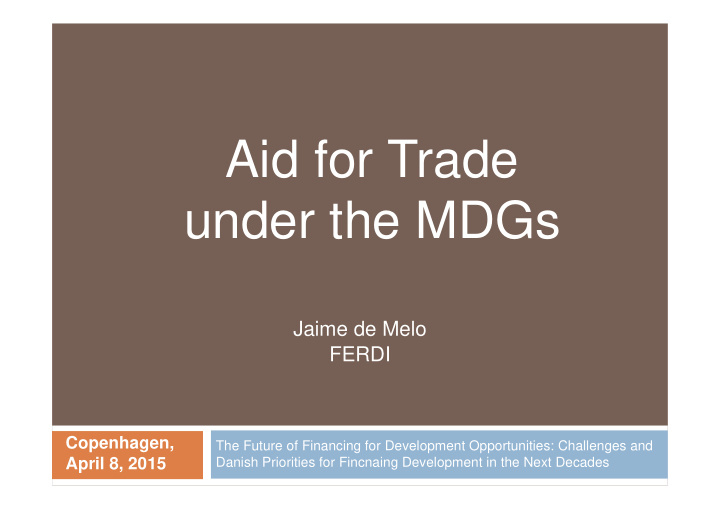



Aid for Trade under the MDGs Jaime de Melo FERDI Copenhagen, The Future of Financing for Development Opportunities: Challenges and April 8, 2015 Danish Priorities for Fincnaing Development in the Next Decades
The AFT Initiative Rationale: Trade is an engine of growth and growth trickles down (incomes of bottom 20 percent of distribution rise in proportion to average incomes) AFT initiative (2005): Extend funding beyond IF/EIF (targeted to LDCs). MDG goal #8 (‘develop a global partnership for development’ =rule-based, open, transparent multilateral system). Goal re-iterated in SDGs by OWG (also includes target of doubling of exports of LDCs by 2020--stated in IPoA) � On current growth projections trade costs of LDCs will have to fall twice as fast as partners until 2020 to meet IPoA target …so far, LICs have been losing ground 2
AFT Objectives have expanded AFT ≈ $60 billion p.a. Initially two objectives: (i) Provide TA to LDCs to ‘implement and benefit from’ WTO agreements (ii) Raise & disburse funds to support Doha negotiations Objective (ii) took precedence over objective (i) � Haste: Disbursements through existing channels + new issues to keep up support for Doha negotiations: «gender empowerment», «green growth», «Climate change», «GVC»… � AFT evaluation was Muddled (see biennial OECD- WTO reviews (5th due in June 2015) 3
AFT: What have we Learnt? (1) Per capita disbursements have gone up during the AFT period Direct effects? Poverty reduction is not greater for countries receiving, on average, higher per capita aid flows during the AFT period (i) Indirect effects of AFT on exports via infrastructure improvements. (ii) Case studies (e.g. road rehabilitation reducing monopsony power 4 of intermediaries in Sierra Leone).
AFT: What have we Learnt? (2) Wordcount in Uganda’s budget speeches …so sometimes trade is mainstreamed in national developing strategies Other lessons: Better use Diagnostic Trade Integration Studies (DTISs) o DTIS updates already a crude form of monitoring progress : learning curve from first generation o Still lack of ownership (government side) and visibility (donor side) o Need for leaner, more focused action matrices (some progress) o Mainstream regional integration in trade policy (in progress); o Region-level DTISs (not yet started—a priority) 5 Titre de la présentation 10 avril 2015
Next Steps: The Trade Facilitation Agreement (TFA) Signed by all WTO members: TFA has TA component. Several plusses: • Lends itself to quantifiable objectives (bringing customs management towards best practice) easily monitored. • In line with Paris Principles (country ownership, alignment, harmonization, managing for development results, and mutual accountability). • Focus on LDCs and LL-LDCS contribute towards ‘inclusive growth’ � In sum taking TFA ‘seriously’ = focus on measurable targets à la MDGs � � � Table 1: Summary statistics, average over 2005-2011. Poverty Poverty GDP pc GDP pc AFT AFT / WGI c Categories Headcount Gap b growth per capita GDP Ratio a Landlocked LDC (16) 72,3 35,3 507 3,9% 21,5 3,7% -0,72 Non-landlocked LDC (33) 66,5 31,9 1192 2,3% 34,2 3,4% -0,78 Landlocked non-LDC (14) 20,7 7,7 2067 4,5% 19,7 1,2% -0,65 Other Developing (87) 21,4 8,2 4833 2,6% 29,2 0,8% -0,17 Source: OECD-DAC, WDI and Povcal.net ….but beware of the tensions between AFT for « infrastructure » and « safeguard » of environement under SDGs 6
References Boussichas, M. and P. Guillaumont eds. (2015) Financing Development: Addressing Vulnerabilities , Economica, Forthcoming Cadot, O. and Melo, J. de, eds. (2014), Aid for Trade: What Have we learnt? Which Way Ahead?, http://www.ferdi.fr//sites/www.ferdi.fr/files/publication/fichiers/aid_for_trade.pdf , e-book CEPR and FERDI. Melo, J. de and L. Wagner (2015) “Aid for Trade as Finance for the Poor”, FERDI WP#125 http://www.ferdi.fr/fr/node/2081 Pritchett, L. (2015) “Can Rich Countries be Reliable Partners for National Development?” Essay, Center for Global Development, Washington, D.C. 7
Recommend
More recommend